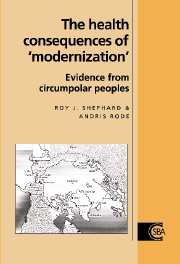Book contents
- Frontmatter
- Contents
- Preface
- 1 The circumpolar habitat and its peoples: traditional lifestyle and early research findings
- 2 Concept of the International Biological Programme Human Adaptability Project, and IBP studies of circumpolar populations
- 3 Changes in social structure and behaviour
- 4 Secular trends in diet, metabolism and body composition
- 5 Secular trends in physical fitness and cold tolerance
- 6 Secular trends in respiratory hazards, lung function and respiratory disease
- 7 Secular trends in growth and development
- 8 Current health status of circumpolar populations
- 9 Postscript: lessons from traditional circumpolar life and options for the future
- References
- Index
1 - The circumpolar habitat and its peoples: traditional lifestyle and early research findings
Published online by Cambridge University Press: 05 March 2012
- Frontmatter
- Contents
- Preface
- 1 The circumpolar habitat and its peoples: traditional lifestyle and early research findings
- 2 Concept of the International Biological Programme Human Adaptability Project, and IBP studies of circumpolar populations
- 3 Changes in social structure and behaviour
- 4 Secular trends in diet, metabolism and body composition
- 5 Secular trends in physical fitness and cold tolerance
- 6 Secular trends in respiratory hazards, lung function and respiratory disease
- 7 Secular trends in growth and development
- 8 Current health status of circumpolar populations
- 9 Postscript: lessons from traditional circumpolar life and options for the future
- References
- Index
Summary
The circumpolar habitat
Boundaries
The circumpolar region is defined by climate and culture, rather than by a specific latitude such as the Arctic circle. Geographic and climatic markers include the tree line, the zone of perennially frozen ground that even in summer only thaws superficially (the permafrost), and the mean July isotherm of 10°C (Bone, 1992; Burch, 1986; Damas, 1984; Kimble & Good, 1954; Péwé, 1966; Wenzel, 1991). These various boundaries have shifted markedly over the past 10–20 millenia (Lamb, 1965). During the last Pleistocene period of glaciation, ice covered much of North America, Europe and Asia.
The cultural criterion of the circumpolar habitat, at least in North America, has traditionally been the region exploited by a people that early investigators, ourselves included, sometimes termed Eskimos (Damas, 1984). ‘Inuk’ (‘Inuuk,’ two, three or more ‘Inuit’) is the descriptor currently preferred, at least by the Canadian segment of this population. Also, some Amerindian groups can be found living within the geographic boundaries of the circumpolar region even in North America.
Climate
Throughout the circumpolar territories, the temperature remains below freezing for much of the year, and in some of the colder settlements of the eastern Canadian arctic mean daily air temperatures as low as −50 to −60 °C are recorded during the winter months. The average windspeed is about 5m/s (18km/h), but windspeeds of 10m/s (36km/h) and higher are encountered on some days, and then the windchill is particularly severe (Landsberg, 1970). In contrast, the 24 hour sunshine of late June and early July can occasionally bring mean daily temperatures as high as 25°C.
- Type
- Chapter
- Information
- The Health Consequences of 'Modernisation'Evidence from Circumpolar Peoples, pp. 1 - 42Publisher: Cambridge University PressPrint publication year: 1996
- 1
- Cited by



